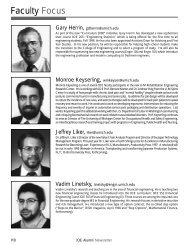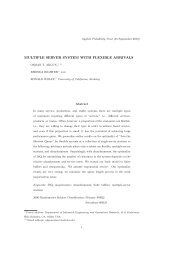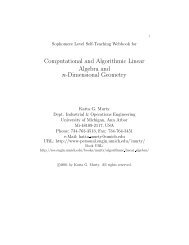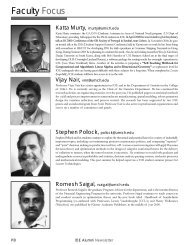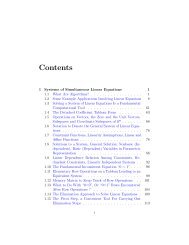Optimization Models For Decision Making: Volume 1
Optimization Models For Decision Making: Volume 1
Optimization Models For Decision Making: Volume 1
You also want an ePaper? Increase the reach of your titles
YUMPU automatically turns print PDFs into web optimized ePapers that Google loves.
Junior Level Self-Teaching Web-Book for<br />
<strong>Optimization</strong> <strong>Models</strong> <strong>For</strong><br />
<strong>Decision</strong> <strong>Making</strong>: <strong>Volume</strong> 1<br />
Katta G. Murty<br />
Dept. Industrial & Operations Engineering<br />
University of Michigan, Ann Arbor<br />
Mi-48109-2117, USA<br />
Phone: 734-763-3513, Fax: 734-764-3451<br />
e-Mail: murty@umich.edu<br />
URL: http://www-personal.engin.umich.edu/˜murty/<br />
c�2003 by Katta G. Murty. All rights reserved.<br />
i
Contents<br />
This is Chapter 0 of “Junior Level Web-Book for <strong>Optimization</strong><br />
<strong>Models</strong> for decision <strong>Making</strong>” by Katta G. Murty.<br />
Preface<br />
Glossary<br />
1 <strong>Models</strong> for <strong>Decision</strong> <strong>Making</strong> 1<br />
1.1 <strong>Decision</strong><strong>Making</strong> ..................... 1<br />
1.2 AModelforaSimple<strong>Decision</strong><strong>Making</strong>Problem.... 7<br />
1.3 <strong>Optimization</strong><strong>Models</strong>................... 9<br />
1.4 <strong>Optimization</strong>inPractice................. 15<br />
1.5 VariousTypesof<strong>Optimization</strong><strong>Models</strong> ......... 16<br />
1.6 BackgroundNeeded.................... 17<br />
1.7 Exercises.......................... 17<br />
1.8 References......................... 18<br />
2 The Scoring Method for Category 1 <strong>Decision</strong> Problems 21<br />
2.1 Category 1 <strong>Decision</strong> <strong>Making</strong> Problems, Multi-Characteristic<br />
<strong>Decision</strong><strong>Making</strong> ..................... 21<br />
2.2 Transformations Needed to Apply the Scoring Method,<br />
andOtherImportantConsiderations .......... 23<br />
2.3 SummaryoftheScoringMethod............. 29<br />
2.4 NumericalExamples ................... 30<br />
2.5 Caution:ShortcomingsoftheScoringMethod ..... 36<br />
2.6 Exercises.......................... 40<br />
3 LP <strong>For</strong>mulations 57<br />
3.1 Category2<strong>Decision</strong><strong>Making</strong>Problems ......... 57<br />
3.2 The Scope of LP Modeling Techniques Discussed in this<br />
Chapter .......................... 60<br />
3.3 Each Inequality Constraint Contains a Hidden New VariableCalleditsSlackVariable<br />
.............. 60<br />
iii
iv<br />
3.4 ProductMixProblems .................. 68<br />
3.5 BlendingProblems.................... 75<br />
3.6 TheDietProblem..................... 80<br />
3.7 TheTransportationProblem............... 83<br />
3.8 TheAssignmentProblem................. 88<br />
3.9 A Multi-Period Production<br />
PlanningProblem..................... 96<br />
3.10 Examples Illustrating Some of the Approximations Used<br />
in<strong>For</strong>mulatingRealWorldProblems .......... 98<br />
3.11MaterialforFurtherStudy................ 104<br />
3.12GraphicalMethod..................... 105<br />
3.13 What Planning Information Can<br />
BeDerivedfromanLPModel? ............. 108<br />
3.14TheRoleofLPintheWorldofMathematics...... 113<br />
3.15Exercises.......................... 114<br />
4 The Simplex Method for Solving LPs 149<br />
4.1 Transformations to be Carried Out On an LP Model<br />
Before Applying the Simplex Method On It ...... 151<br />
4.2 Definitions of Various Types of Basic Vectors for the<br />
Problem .......................... 161<br />
4.3 HowDoesthe(Primal)SimplexMethodWork? .... 173<br />
4.4 How Does the Simplex Algorithm Move From One FeasibleBasicVectortoaBetterone?<br />
........... 177<br />
4.5 The(Primal)SimplexMethod.............. 183<br />
4.6 NumericalExamplesoftheSimplexMethod ...... 192<br />
5 Duality, Marginal and Sensitivity Analysis in LP 209<br />
5.1 Derivation of the Dual of the Fertilizer Problem Through<br />
RationalEconomicArguments.............. 210<br />
5.2 DualoftheLPInStandard<strong>For</strong>m............ 214<br />
5.3 The Dual of the Balanced Transportation Problem . . 219<br />
5.4 Relatioship of Dual Slack Variables to the Relative Cost<br />
CoefficientsintheSimplexMethod ........... 222<br />
5.5 SomePrimal,DualProperties .............. 228<br />
5.6 MarginalAnalysis..................... 230
5.7 SensitivityAnalysis.................... 233<br />
5.8 Exercises.......................... 238<br />
6 Primal Algorithm for the Transportation Problem 245<br />
6.1 TheBalancedTransportationProblem ......... 245<br />
6.2 AnApplicationataBusRentalCompany ....... 246<br />
6.3 SpecialPropertiesoftheProblem............ 249<br />
6.4 NotationUsedtoDisplaytheData ........... 252<br />
6.5 Routine for Finding an Initial Feasible Basic Vector and<br />
itsBFS .......................... 253<br />
6.6 How to Compute the Dual Basic Solution and Check<br />
Optimality......................... 262<br />
6.7 A Pivot Step: Moving to an Improved Adjacent Basic<br />
Vector ........................... 264<br />
6.8 The Primal Simplex Algorithm for the Balanced TransportationProblem<br />
.................... 274<br />
6.9 Marginal Analysis in the Balanced Transportation Problem.............................<br />
278<br />
6.10 What to do if There is Excess Supply or Demand . . . 280<br />
6.11Exercises.......................... 282<br />
7 Modeling Integer and Combinatorial Programs 287<br />
7.1 Types of Integer Programs, an Example Puzzle Problem,<br />
andaClassicalSolutionMethod............. 287<br />
7.2 TheKnapsackProblems ................. 296<br />
7.3 Set Covering, Set Packing, and<br />
SetPartitioningProblems ................ 302<br />
7.4 PlantLocationProblems................. 323<br />
7.5 BatchSizeProblems ................... 328<br />
7.6 Other“Either,Or”Constraints ............. 330<br />
7.7 IndicatorVariables .................... 333<br />
7.8 DiscreteValuedVariables ................ 340<br />
7.9 TheGraphColoringProblem .............. 340<br />
7.10TheTravelingSalesmanProblem(TSP) ........ 348<br />
7.11Exercises.......................... 350<br />
7.12References......................... 371<br />
v
vi<br />
8 The Branch and Bound Approach 375<br />
8.1 The Difference Between Linear<br />
andIntegerProgramming<strong>Models</strong> ............ 375<br />
8.2 The Three Main Tools in the Branch and Bound Approach377<br />
8.3 The Strategies Needed to Apply the Branch and Bound<br />
Approach ......................... 380<br />
8.3.1 The Lower Bounding Strategy . ......... 381<br />
8.3.2 TheBranchingStrategy ............. 382<br />
8.3.3 TheSearchStrategy ............... 385<br />
8.4 The 0−1 KnapsackProblem............... 393<br />
8.5 TheGeneralMIP..................... 405<br />
8.6 B&B Approach for Pure 0−1 IPs ............ 409<br />
8.7 Advantages and Limitations of the B&B Approach, RecentDevelopments<br />
.................... 417<br />
8.8 Exercises.......................... 420<br />
8.9 References......................... 423<br />
9 Heuristic Methods for Combinatorial <strong>Optimization</strong> Problems<br />
425<br />
9.1 WhatAreHeuristicMethods?.............. 425<br />
9.2 WhyUseHeuristics? ................... 426<br />
9.3 General Principles in<br />
DesigningHeuristicMethods............... 431<br />
9.4 GreedyHeuristics..................... 434<br />
9.4.1 A Greedy Method for the 0−1 Knapsack Problem 434<br />
9.4.2 A Greedy Heuristic for the Set Covering Problem 437<br />
9.4.3 Greedy-TypeMethodsfortheTSP ....... 443<br />
9.4.4 A Greedy Method for the Single Depot Vehicle<br />
RoutingProblem ................. 450<br />
9.4.5 GeneralCommentsonGreedyHeuristics.... 455<br />
9.5 InterchangeHeuristics .................. 457<br />
9.5.1 Interchange .................... 462<br />
9.6 GeneralLocalSearchMethods.............. 466<br />
9.7 Simulated Annealing ................... 476<br />
9.8 GeneticAlgorithms.................... 481<br />
9.9 HeuristicsforGraphColoring .............. 493
9.10TheImportanceofHeuristics .............. 498<br />
9.11Exercises.......................... 499<br />
9.12References......................... 508<br />
10 Dynamic Programming (DP) 511<br />
10.1Sequential<strong>Decision</strong>Processes .............. 511<br />
10.2 Backwards Recursion, a Generalization of Back Substitution<br />
........................... 521<br />
10.3StateSpace,Stages,RecursiveEquations........ 524<br />
10.4 To Find Shortest Routes in a<br />
StagedAcyclicNetwork ................. 530<br />
10.5ShortestRoutes-2.................... 534<br />
10.6 Solving the Nonnegative Integer<br />
KnapsackProblemByDP................ 539<br />
10.7 Solving the 0−1 KnapsackProblembyDP....... 542<br />
10.8ADiscreteResourceAllocationProblem ........ 547<br />
10.9Exercises.......................... 553<br />
10.10References......................... 563<br />
11 Critical Path Methods in Project Management 565<br />
11.1TheProjectNetwork................... 566<br />
11.2ProjectScheduling .................... 577<br />
11.3Exercises.......................... 586<br />
11.4References......................... 592<br />
12 Bridging the Gap Between Theory & Practice in Optimum<br />
decision <strong>Making</strong> 595<br />
vii
viii<br />
PREFACE<br />
Importance of <strong>Decision</strong> <strong>Making</strong> Skills for<br />
Engineering and Business Professionals<br />
The daily work of an engineering or a business professional involves<br />
making a series of decisions. In fact, the human world runs on systems<br />
designed by engineers and business people. That’s why the quality of<br />
decisions made by these two professionals is of critical importance to<br />
the health of the world we live in, and should be of great concern to<br />
every human being.<br />
These decisions are made by looking at the relevant data and making<br />
a manual judgement, usually without the help of quantitative analysis<br />
based on an appropriate mathematical model; that’s why we can<br />
call this the “manual method of making decisions”.<br />
<strong>Making</strong> decisions on issues with important consequences has become<br />
a highly complex problem due to the many competing forces under<br />
which the world is operating today, and the manual method very<br />
often leads to decisions quite far from being optimal. In fact many bad<br />
decisions are being made daily due to this.<br />
Many companies have become aware of this problem, and have made<br />
efforts to use mathematical models for decision making, and even spent<br />
considerable sums of money to acquire software systems to solve these<br />
models. However, often the software sits unused because the people<br />
who make the decisions are not trained in using it properly. Or, the<br />
results obtained by the software may not be practical due to an inappropriate<br />
mathematical model being used for the problem. Intelligent<br />
modeling is essential to get good results. After a disappointing<br />
experience with modeling, companies usually go back to their traditional<br />
practice of manual decision making.<br />
This points out the importance of developing good mathematical<br />
modeling skills in engineering and business students. Some knowledge<br />
of algorithms used to solve these models, their implementations,<br />
how they work, and their limitations, is equally important in order to<br />
make the best use of the output from them. That’s why mathematical
modeling, computational, and algorithmic skills are very important for<br />
engineering and business students today, so that they can become good<br />
decsion makers.<br />
Books in Self-Teaching Style<br />
Present day undergraduate population in engineering and business<br />
schools find textbooks with a theoretical flavor unappealing as they do<br />
not help them acquire the important “mathematical modeling” skill.<br />
Also, students are demanding books that discuss the intricacies in applying<br />
the methods successfully, in a “self-teaching” style that they<br />
can use to learn the subject and its applications mostly by themselves.<br />
They want the textbook designed to help carry out a major portion of<br />
the learning process by her/himself outside the classroom.<br />
As an example of the possibility of self-learning, I can mention the<br />
following historical incident. This incident is the strangest of “mathematicaltalks”evergiven.IttookplaceinOctober1903attheAmerican<br />
Mathematical Society meeting. The “speaker” was Professor Cole,<br />
and the title of the talk was “Mersenne’s claim that a =2 67 − 1isa<br />
prime number”.<br />
This claim has fascinated mathematicians the world over since the<br />
1600s. Not a single word was spoken at the seminar by anyone including<br />
the speaker. He started by writing on the blackboard a =<br />
147573952589676412927. Then he wrote 761838257287, and underneath<br />
it 193707721. Without opening his mouth, he multiplied the two<br />
numbers by hand to get a, and then sat down.<br />
Everyone there instantly understood the result obtained by Cole,<br />
and the very short and silent seminar ended with a wild applause from<br />
the audience.<br />
The Purpose of this Book<br />
The purpose of this book is to serve as a text for developing the<br />
mathmatical modeling, computational, and algorithmic skills of optimization,<br />
and some of their elementary applications at the junior level<br />
following a linear algebra course.<br />
ix
x<br />
It has many modeling and numerical examples and exercises to illustrate<br />
the use of introductory level modeling techniques, how the<br />
algorithms work and the various ways in which they can terminate,<br />
the types of problems to which they are applicable, what useful planning<br />
conclusions can be drawn from the output of the algorithm, and<br />
the limitations of these models and algorithms. Hopefully the many<br />
worked out examples and illustrations, and simple explanations, make<br />
it possible to study and understand most of the material by oneself,<br />
and the rest with occasional help from the instructor.<br />
The wide variety and large number of exercises in the book help<br />
the students develop problem solving skills.<br />
Why Web-Book?<br />
The web-format makes it much easier and convenient to deliver the<br />
content of the book to the students directly without any middle-men,<br />
and thus at a much lower price compared to the hard copy format. Each<br />
chapter is prepared with its separate index and kept in a separate file,<br />
this way they need to print only those chapters covered in the course<br />
(may not need to print the whole book). Among the end of chapter<br />
exercises in each chapter, only the ones most likely to be used frequently<br />
are kept in the chapter, the rest are included in a final chapter called<br />
“Additional Exercises”, arranged chapterwise. Also, when students<br />
print something, they usually print 8 pages per sheet. These formats<br />
help save a lot of paper. In fact some students may prefer reading<br />
the book on their screen, but I hope that all will print only the most<br />
essential parts, and thus conserve paper for making which we are killing<br />
a lot of trees.<br />
Preview<br />
Chapter 1 introduces mathematical modeling using a simple one<br />
variable example. This chapter also explains the classification of decision<br />
making problems into Category 1, and Category 2.<br />
Chapter 2 discusses MCDM (multi-characteristic decision making)<br />
problems. It explains the commonly used Scoring Method for solving
Category 1 decision making problems when there are several important<br />
characteristics that need to be optimized simultaneously, with many<br />
simple examples.<br />
Chapter 3 deals with elementary modeling techniques for modeling<br />
continuous variable decision making problems in which linearity<br />
assumptions hold to a reasonable degree of approximation, as linear<br />
programs (LPs), in a variety of applications. The geometric method<br />
for solving two variable LP models is discussed along with the concept<br />
of marginal values and their planning uses.<br />
Chapter 4 discusses the simplest version of the primal simplex<br />
method for solving LPs using full canonincal tableaus, which students<br />
at this level can follow easily; and explains it with many worked out<br />
examples.<br />
Chapter 5 gives the derivation of the dual problem of an LP using<br />
economic arguments, and the marginal value interpretation of the dual<br />
variables. It discusses the optimality conditions (primal and dual feasibility,<br />
and complementary slackness) for an LP, and the role they play<br />
in the simplex method. Marginal analysis, and a few important coefficient<br />
ranging and sensitivity analysis techniques are also discussed.<br />
Chapter 6 treats the simplified version of the primal simplex algorithm<br />
for the transportation model using transportation arrays.<br />
Chapter 7 presents techniques for modeling integer and combinatorial<br />
optimization problems. It shows that many different combinatorial<br />
constraints that appear frequently in applications, can be modeled using<br />
linear constraints in binary variables. The importance of 0-1 integer<br />
programming models is highlighted with interesting examples drawn<br />
from puzzle literature and the classics, which students at this age find<br />
very engaging.<br />
Chapter 8 discusses the branch and bound approach for solving<br />
integer and combinatorial optimization problems, and its advaltages<br />
and limitations.<br />
The amount of computer time needed for solving discrete and combinatorial<br />
optimization problems with branch and bound or other exact<br />
methods available today grows rapidly as problem size increases. So,<br />
at present it is practical to solve only moderate sized problems of this<br />
type exactly. Consequently, when faced with large scale versions of<br />
xi
xii<br />
these problems, most practitioners use heuristic approaches to obtain<br />
the best possible approximate solution within a reasonable time. Surprisingly,<br />
well designed heuristic methods seem to produce satisfactory<br />
solutions to many hard and complex problems. So, heuristic methods<br />
are now mainstream for decision making, and the exact methods<br />
developed in theory have become tools for designing good heuristics.<br />
Chapter 9 discusses the principles for designing good heuristic methods<br />
(greedy methods, local search methods, simulated annealing, genetic<br />
algorithms) for different problems with many examples.<br />
Chapter 10 explains the recursive technique for solving deterministic<br />
dynamic programming problems. Chapter 11 deals with the very<br />
important critical path methods for project scheduling and management,<br />
using the dynamic programming algorithm for optimal chains in<br />
networks.<br />
There is a wide gulf between the mathematical models for solving<br />
which we have efficient algorithms, and real world decision making<br />
problems. The brief Chapter 12 explains how heuristic approaches, approximations,<br />
substitute objective function techniques, and intelligent<br />
modeling techniques are helping to bridge this wide gap.<br />
Finally the last chapter, Chapter 13, contains additional end of the<br />
chapter exercises for earlier chapters.<br />
Contributions Requested<br />
No funding could be obtained for my effort in preparing this book.<br />
Also, everyone who uses this web-book, saves the cost of buying an<br />
expensive paper-book containing this material. I request each such<br />
user to honestly contribute about US$15 (or more if you like) of the<br />
amount you save to my address:<br />
Professor Katta G. Murty<br />
Department of Industrial and Operations Engineering<br />
University of Michigan<br />
Ann Arbor, MI-48109-2117, USA<br />
to partly compensate for my time in preparing it. The money received
xiii<br />
will be used to maintain and make improvements in this website, and<br />
in preparing <strong>Volume</strong> 2 of this book at the Master’s level.<br />
If you are a faculty member using this book in a course, please<br />
encourage your students to contribute. In your first class you may<br />
select a student to collect from everyone in the class, and then mail the<br />
amount collected to my above address.<br />
Numbering Scheme for Equations, Exercises,<br />
Etc.<br />
Equations, results, theorems, some examples and tables, withinsection<br />
exercises, are all numbered serially in each section; so an entity<br />
like this with number i.j.k refers to the kth of this entity in Section i.j.<br />
End of the chapter exercises at the end of each chapter are nubered<br />
serially in each chapter. So Exercise i.j referes to the jth exercise at<br />
the end of Chapter i. Similarly figures are numbered serially in each<br />
chapter, so Figure i.j refers to the jth figure in Chapter i.<br />
References<br />
Exercises based on material discussed in published papers from journals<br />
are included in several chapters. In some of these chapters the<br />
reference is cited right at the end of that exercise. In others where<br />
there are a lot of such exercises, these references are listed at the end<br />
of the chapter in alphabetical order of the fiirst authors last name.<br />
A selected list of textbooks for further reading is given at the end<br />
of Chapter 12.<br />
Each Chapter in a Separate file<br />
In paperbooks all chapters are always put together between two<br />
covers and bound. But for a webbook I feel that it is convenient to have<br />
each chapter in a separate file to make it easier for users to download.<br />
That’s why I am putting each chapter as a separate file, beginning with<br />
its individual table of contents, and ending with its own index of terms<br />
definedinit.
xiv<br />
Acknowledgements<br />
Figures, and Suggestions to make material easier to read:<br />
On a Marian Sarah Parker Scholarship during Summer 2004, Priti Shah<br />
helped me by drawing all the figures in the book. She read Chapters 7<br />
to 12 very carefully and provided several suggestions to make this portion<br />
easier to understand by Junior level students. Earlier on another<br />
Marian Sarah Parker Sholarship during Summer 2003, Shital Thekdi<br />
read Chapters 1 to 6 very carefully and made suggestions for improving<br />
the exposition in them. I am grateful to Priti and Shital, and to the<br />
University of Michigan Marian Sarah Parker Scholarship Administration<br />
for this help.<br />
My heartfelt thanks to A. Ravi Ravindran, and Robert Bordley for<br />
providing examples, and exercises in Chapter 2.<br />
Suggestions, corrections, and many other kinds of help have been<br />
received from several others too numerous to mention by name, and I<br />
express my heartfelt thanks to all of them.<br />
Some portions in this book are revised versions of those in my 1995<br />
book Operations Research: Deterministic <strong>Optimization</strong> <strong>Models</strong> published<br />
by Prentice Hall Inc. I received special permission (PE Reference<br />
#104672, dated 12 August 2004) to include these in this book<br />
from Pearson Education. I thank them for giving me this permission.<br />
Katta G. Murty<br />
Ann Arbor, MI, December 2005.
xvi<br />
Glossary of Symbols and Abbreviations<br />
Equations, results, theorems, some examples and tables, withinsection<br />
exercises, are all numbered serially in each section; so an entity<br />
like this with number i.j.k refers to the kth of this entity in Section i.j.<br />
End of the chapter exercises at the end of each chapter are nubered<br />
serially in each chapter. So Exercise i.j referes to the jth exercise at<br />
the end of Chapter i.<br />
Similarly figures are numbered serially in each chapter, so Figure<br />
i.j refers to the jth figure in Chapter i.<br />
Abbreviations in alphabetical order<br />
AOA Activity-on-arc project network, also called the arrow diagram<br />
for the project.<br />
AON Activity-on-node project network.<br />
B&B Branch and bound approach or algorithm.<br />
BFS Basic feasible solution for a linear program.<br />
BV A branching variable used in the branching operation in<br />
a B&B. However, in earlier linear programming chapters,<br />
this abbreviation is used for either basic vector or basic<br />
variables.<br />
CP Candidate problem in a B&B.<br />
CPM Critical path method for project scheduling.<br />
CS Complementary slackness optimality conditions for a linear<br />
program.<br />
DP Dynamic programming.<br />
EF(i, j), ES(i, j) Early finish (early start) times associated with job (i, j)<br />
in project scheduling.<br />
FIFO First in first out strategy for selecting objects from a<br />
queue.<br />
GA Genetic algorithm.<br />
GJ Gauss-Jordan (pivot step, algorithm).
xvii<br />
iff If and only if.<br />
I/O Input-output coefficients in a linear program.<br />
IP Integer program.<br />
LA Linear algebra.<br />
LB Lower bound for the minimum objective value in a CP.<br />
LIFO Last in first out strategy for selecting objects from a<br />
queue.<br />
LP Linear program.<br />
LF(i, j), LS(i, j) Late finish (late start) times associated with job (i, j) in<br />
project scheduling.<br />
MCDM Multi-characteristic decision making problem.<br />
MDR Minimum daily requirement for a nutrient in a diet<br />
model.<br />
MIP Mixed integer program.<br />
NLP Nonlinear programming.<br />
Oc.R Octane rating of gasoline.<br />
OR Operations Research.<br />
OVF Optimum value function in DP.<br />
PC Pivot column (for a GJ pivot step, or in the simplex<br />
method).<br />
POS A partially ordered set.<br />
PR Pivot row (for a GJ pivot step, or in the Simplex<br />
method).<br />
PMX Partially matched crossover operation in a GA for permutation<br />
or tour problems.<br />
RHS Right hand side (constants, or vector of constants in an<br />
LP).<br />
RO Relaxed optimum (in the LB strategy in B&B).<br />
SA Simulated annealing algorithm.<br />
TSP Traveling salesman problem.<br />
WRT With respect to.<br />
Symbols dealing with sets:<br />
R n The n-dimensional real Euclidean vector space. The<br />
spaceofallvectorsoftheformx =(x1,...,xn) T (written<br />
either as a row vector as here, or as a column vector)<br />
where each xj is a real number.<br />
\ Set difference symbol. If D, E are two sets, D\E is the<br />
set of all elements of D which are not in E.<br />
|F| Cardinality of the set F
xviii<br />
∈ Set inclusion symbol. a ∈ D means that a is an element<br />
of D. b �∈ D means that b is not an element of D<br />
⊂ Subset symbol. E ⊂ F means that set E is a subset of<br />
F, i.e., every element of E is an element of F<br />
∪ Set union symbol<br />
∩ Set intersection symbol<br />
∅ The empty set<br />
Symbols dealing with vectors:<br />
=, ≥, ≤ Symbols for equality, greater than or equal to, less than<br />
or equal to, which must hold for each component in a<br />
vector.<br />
||x|| Euclidean norm of vector x = (x1,...,xn), it is<br />
�<br />
x 2 1 + ...+ x 2 n. Euclidean distance between two vectors<br />
x, y is ||x − y||.<br />
Symbols dealing with matrices:<br />
(aij) Matrix with aij as the general element in it.<br />
x T ,A T Transpose of vector x, matrix A.<br />
A −1 Inverse of the nonsingular square matrix A.<br />
Ai.,A.j The ith row vector, jth column vector of matrix A.<br />
rank(A) RankofamatrixA, same as the rank of its set of row<br />
vectors, or its set of column vectors.<br />
Symbols dealing with real numbers:<br />
|α| Absolute value of real number α.<br />
n! n factorial.<br />
∞ Infinity.<br />
� Summation symbol
Symbols dealing with networks or graphs:<br />
N The finitesetofnodesinanetwork<br />
A The set of lines (arcs or edges) in a network<br />
G =(N , A) A network with node set N and line set A<br />
xix<br />
(i, j) An arc (directed line) joining node i to node j<br />
(i; j) An edge (undirected line) joining nodes i and j<br />
Symbols dealing with LPs and IPs:<br />
xj,xij,x xj is the jth decision variable in an LP or IP. xij is the<br />
decision variable associated with cell (i, j) inanassgnment<br />
or a transportation problem, or a TSP. x denotes<br />
the vector of these decision variables.<br />
cij; cj,c The unit cost coefficient or length or weight of arc (or<br />
cell in an array)(i, j) oredge(i; j) isdenotedbycij. cj is<br />
the original cost coefficient of a variable xj in an LP or<br />
IP model. c is the vector of cij or cj.<br />
πi, π Dual variable associated with the ith constraint in an LP,<br />
the vector of dual variables.<br />
u =(ui),v =(vj) Vectors of dual variables associated with rows, columns<br />
of a transportation array.<br />
¯cj, ¯cij, ¯c The reduced or relative cost coefficient of variables xj, xij<br />
in an LP, or the transportation problem. ¯c is the vector<br />
oftheserelativecostcoefficients.<br />
n, m Usually, number of variables, constraints in an LP or IP.<br />
Also, the number of sinks (columns in a transportation<br />
array), and the number of sources (rows in the transportation<br />
array) in a transportation problem. The symbol<br />
n also denotes the number of cities in a TSP.<br />
ai,bj In a transportation problem, these are the amounts of<br />
material available for shipment at source i, requiredat<br />
sink j respectively.<br />
θ Usually the minimum ratio in a pivot step in the simplex<br />
algorithm for solving an LP or a transportation problem.
xx<br />
B Usually denotes a basis for an LP in standard form.<br />
xb,xD the vectors of basic (dependent), nonbasic (independent)<br />
variables WRT a basis for an LP.<br />
0 − 1 variable A variable that is constrained to take values of 0 or 1.<br />
Also called “binary variable” or “boolean variable”.<br />
1, 2,...,n; 1 A tour for a TSP beginning and ending at city 1, indicating<br />
the order in which the various cities are visited.<br />
Other symbols:<br />
O(n r ) Whenn is some measure of how large a problem is (either<br />
the size (number of digits in the data when it is encoded<br />
in binary form), or some quantity which determines the<br />
number of data elements), a finitely terminating algorithmforsolvingitissaidtobeofordern<br />
r or O(n r ), if<br />
the computational effort required by it is bounded above<br />
by αn r ,whereα is a constant independent of the size and<br />
the data in the problem.<br />
�� This symbol indicates the end of the present portion of<br />
text (i.e., example, exercise, comment etc.). Next line<br />
either resumes what was being discussed before this portion<br />
started, or begins the next portion.




